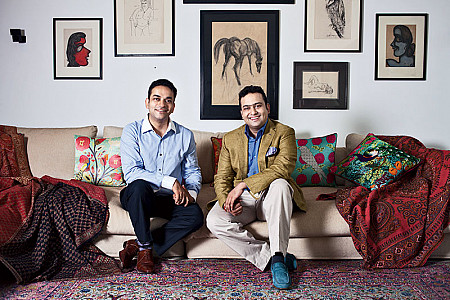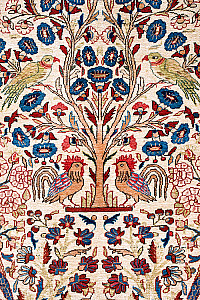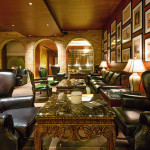Meet the Carpet Cousins

It’s from the 16th century, from Mughal times. Could very well be the carpet that Emperor Akbar had in his Deewan-e-Khaas. The abrash gradations on it’s subtle surface create an interplay of colours that bring movement – a veritable 3D effect. I am walking on this silken texture now. These are rugs that are sold for millions of dollars at Sotheby auctions. I am walking on it now….
When you descend into the quiet cellar…it is like entering a chamber of secrets. Feels as if, step after step, clandestine items will be revealed. The scent of lemongrass oil welcomes you inside, where piles and piles of antique rugs are laid all over. In one corner, a group of artisans is working on restoring an 18th century find. Looks like they have just started work on it but it happens that they have been on it for days now. “Restoration is different from repair: the former being more of a science which requires specialised skills and knowledge of wool, dyes, knots and structure and their inception,” says Dhruv Chandra, the younger of the two cousins who have inherited the business of exclusive, antique throws.
The older one, Nishant handles the commercial aspect of the business but he too has good understanding of floor covering as both boys were summoned to the warehouse every day after school to learn their wool and carpet business by Nishant’s father and Dhruv’s paternal uncle Sheel Chandra. This is in fact, his private collection of museum quality carpets, carefully chosen over 35 years from New Zealand, Thailand, Persia, Turkey, China amongst other countries. Some of these are from private estates and auctions of royal families. Sheel Chandra didn’t have any knowledge or expertise of carpets but kept buying out of sheer love and learnt more with each purchase. The collection is the second largest in Asia, competing with the Sultan of Brunei who holds the world record.
While Dhruv went to study more about wool in Australia, he knew carpets were his real calling. He explained how antique carpets are not expensive because they are hundreds of years old; rather, they come at a price because of the workmanship and raw material of that era, which he says is incomparable today. “Back then, a carpet had 15 to 20 kilos of the finest Pashmina wool or raw silk that cost almost Rs 20,000 in today’s money and sometimes, it took 10 years to complete one carpet with the best weavers, with great natural dyes and exquisite knotting techniques being used. The best wool at the moment is priced at Rs 1000 a kilo and carpets are made in less than two months, cheating on knots; that should explain a lot. In this world of adulteration, quality is diluted automatically,” he says. “Things like the DNA structure of the animal from where the wool comes and how it affects the amount of dye each fibre consumes, matter a lot. Then again, the consistency of the dye differs from plant to plant so that makes a difference as well,” he adds.
Nishant enlightened me on the two kinds of antique rugs – the workshop variety and tribal rugs. “The workshop ones are city rugs made for commercial purposes, mostly with floral decoration made using a naksha or a hand-drawn plan plotted to graph. The taleem (script) is given by master weavers. Most would have the Gardens of Paradise theme. Tribal rugs are geometrical carpets that are heirloom pieces made for personal use. In certain societies, carpets were treated as a poor person’s assets just like commodities like cows, sheep or land. These were woven by the grandfather or the head of the family and the designs held a lot of symbolism, traditions and folklore. Like pomegranate (fertility), rabbit’s foot (good luck), serpent (power), water (eternal life) or the evil eye to ward off bad luck,” says Nishant.
Dhruv’s favourites are the tribal rugs. “There is no naksha and these are woven with imagination. The process brings out the different skills of each member of the house along with the expression of the weaver and each one tells a story. In those days too, there was fashion in carpets. Certain styles were and are more popular than the others,” he adds.
I was told that in India, the 16th century rugs from Emperor Akbar’s time are special. Art was flourishing then and the Mughals were passionate about rugs and they brought their master weavers along from Persia who taught local craftsman to weave who eventually outshone the masters. Of the antique rugs, not many survived the torrid weather conditions and many others were neglected because for long, carpets weren’t treated as art. It’s only now that people have begun to understand the dying art and how antique rugs keep appreciating in value.
The duo manufactures new carpets as well and hires ex-NIFT graduates and expert craftsmen to draw maps. “World-renowned decorators and interior designers brainstorm in Paris to forecast trends in colours and themes, we bear that in mind but we don’t make carpets keeping the end price point in mind and for doing such work, it’s important to find patronage from seasoned as well as young collectors,” says Dhruv.
Soon, they will be moving to another building, a larger space. A carpet museum in Delhi is in the pipeline. “Carpets are like art; peoples’ tastes differ. Nobody was born with the knowledge of art, architecture and style… your sense of buying good art only grows with time,” says Dhruv who thinks that carpets in India sell on the ignorance of the buyer and that we need more education here. He believes that it will take him a few lifetimes to become an expert. So some parting advice for total novices like me to differentiate a good rug from the bad? “Check the wool, the softer, the better,” he smiles.
Related posts from Verve:
Verve Trending
Sorry. No data so far.
us on Facebook to stay updated with the latest trends






